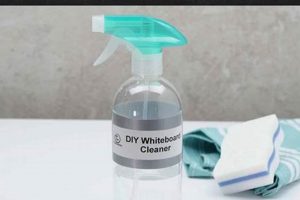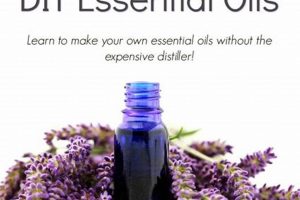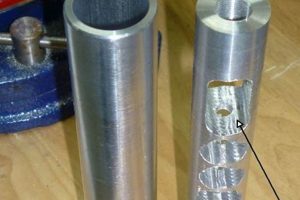The concoction refers to homemade solutions designed to remove sticky residues left behind by adhesives, labels, or other gummy substances. A common example involves combining baking soda with a carrier oil, creating a paste to lift adhesive remnants from surfaces.
Formulating these alternative removers can offer several advantages. It often leverages readily available household ingredients, potentially reducing costs compared to commercially available products. Historically, individuals have sought such alternatives to avoid harsh chemicals or when commercial options are unavailable.
The following sections will explore various recipes for creating effective homemade adhesive removers, examine safety considerations, and provide application tips for optimal results on different surfaces.
Tips for Effective Homemade Adhesive Removal
Achieving optimal results with homemade adhesive removers requires careful consideration of surface compatibility and application techniques. The following tips provide guidance for maximizing the effectiveness of such solutions while minimizing potential damage.
Tip 1: Test in an Inconspicuous Area: Prior to widespread application, test the homemade solution on a small, hidden area of the surface to ensure it does not cause discoloration or damage. Observe for any adverse reactions for at least 30 minutes.
Tip 2: Apply Generously and Allow Sufficient Soak Time: Apply the solution liberally to the adhesive residue, ensuring complete coverage. Allow the solution to dwell for several minutes, or even longer for stubborn residues, to soften the adhesive bond.
Tip 3: Use Gentle Scrubbing Tools: Employ soft cloths, sponges, or plastic scrapers to dislodge the softened residue. Avoid abrasive materials that could scratch or damage the underlying surface. A toothbrush can be useful for intricate areas.
Tip 4: Reapply as Needed: If the adhesive does not fully release with the initial application, reapply the solution and allow it to soak for a longer period. Multiple applications may be necessary for older or heavily bonded residues.
Tip 5: Clean the Surface Thoroughly: After removing the adhesive residue, clean the treated area with a mild soap and water solution to remove any remaining residue from the homemade remover. Dry the surface completely.
Tip 6: Consider Heat for Stubborn Residues: Applying gentle heat from a hairdryer (on a low setting) can help soften stubborn adhesives, enhancing the effectiveness of the homemade solution. Exercise caution to avoid overheating and damaging the surface.
Tip 7: Choose the Right Solution for the Job: Different homemade recipes are better suited for different types of adhesives and surfaces. Research and select the most appropriate solution based on the specific adhesive and surface involved.
By adhering to these guidelines, users can increase the likelihood of successfully removing adhesive residues with homemade solutions while preserving the integrity of the treated surfaces.
The subsequent section will address potential safety precautions when working with household ingredients to create adhesive removers.
1. Ingredient Selection
Effective formulation of homemade adhesive removers necessitates careful selection of ingredients. The choice directly impacts the solution’s ability to dissolve or weaken the adhesive bond without damaging the underlying surface. Misjudgments in ingredient selection can lead to ineffective removal, surface discoloration, or structural damage.
- Solvent Properties and Adhesive Compatibility
The primary function of an ingredient is to act as a solvent, dissolving or weakening the adhesive. Different adhesives exhibit varying solubilities. For instance, petroleum-based adhesives respond well to oils (vegetable, mineral), while water-based adhesives may require a different approach. Selecting an incompatible solvent will render the solution ineffective.
- Surface Material Compatibility
Ingredients must be compatible with the surface from which the adhesive is to be removed. A solvent that effectively dissolves the adhesive may also damage the surface. Acetone, for example, effectively removes many adhesives but can dissolve or discolor certain plastics. Selection should prioritize surface preservation.
- Safety Considerations
Ingredients should pose minimal health risks. Volatile organic compounds (VOCs) found in some solvents can cause respiratory irritation or other health problems. Natural alternatives, such as citrus oils, are often preferred due to their lower toxicity. Safety should be a primary factor in ingredient selection.
- Availability and Cost-Effectiveness
Ingredients should be readily available and cost-effective. While specialized solvents may offer superior performance, their limited availability and higher cost may make them impractical for everyday use. Common household ingredients, such as baking soda and cooking oil, provide a balance of effectiveness, availability, and affordability.
Therefore, the development of successful homemade adhesive removers relies on a nuanced understanding of ingredient properties, surface compatibility, safety concerns, and practical considerations. A judicious selection process maximizes the likelihood of effective adhesive removal while minimizing potential risks.
2. Surface Compatibility
Surface compatibility represents a critical factor in the successful and safe application of homemade adhesive removal solutions. These solutions, often referred to colloquially as “DIY Goo Gone,” are formulated from various household ingredients to dissolve or weaken adhesive bonds. However, the chemical properties of these ingredients can interact unpredictably with different surface materials, potentially causing damage ranging from discoloration and etching to complete structural degradation.
The effectiveness of a “DIY Goo Gone” solution is inextricably linked to its compatibility with the target surface. For example, a solution containing acetone might effectively remove adhesive residue from glass or metal. However, acetone is known to dissolve or severely damage many plastics. Therefore, using such a solution on a plastic surface would likely result in irreparable harm. Similarly, solutions high in acidity, such as those containing vinegar, can corrode certain metals over time. This underscores the necessity of testing any homemade solution on an inconspicuous area of the surface before widespread application. Real-world scenarios frequently involve delicate surfaces like painted walls, finished wood furniture, or sensitive fabrics. Applying an incompatible “DIY Goo Gone” in these situations can lead to costly repairs or replacements. Understanding the chemical composition of both the homemade solution and the surface material is paramount.
In conclusion, s
urface compatibility should be a primary consideration when employing “DIY Goo Gone” solutions. The potential for irreversible damage necessitates thorough research and cautious testing. By prioritizing surface compatibility, users can effectively remove adhesive residues while preserving the integrity and appearance of the underlying material.
3. Residue Type
The efficacy of any homemade adhesive removal solution, often referred to as “diy goo gone,” hinges directly on the type of residue being targeted. Different adhesives possess distinct chemical compositions and bonding properties. Consequently, a “diy goo gone” formulation effective against one type of residue may prove entirely ineffective against another. For example, residues from pressure-sensitive adhesives (found on stickers and tapes) respond well to solvents like oil or alcohol. However, epoxy-based adhesives, which form much stronger, cross-linked bonds, often require more aggressive chemical agents or mechanical removal techniques. Failing to identify the residue type leads to wasted effort, potential surface damage, and ultimately, unsuccessful removal. Correct identification allows for the selection of appropriate solvents, surfactants, or abrasives within the “diy goo gone” mixture, optimizing its performance.
Real-world applications illustrate this principle clearly. Consider the removal of dried glue residue from a child’s art project on a wooden table. A simple “diy goo gone” consisting of vinegar and water may suffice due to the water-based nature of most school glues. Conversely, removing construction adhesive from a concrete floor requires a completely different approach. Solvents like mineral spirits or specialized adhesive removers are often necessary, and the homemade solutions may need to incorporate more potent ingredients or mechanical scraping techniques. Ignoring the residue type and attempting to use the vinegar solution would be a futile exercise, potentially leading to prolonged frustration and no results. Similarly, removing residue from double-sided tape might benefit from a “diy goo gone” incorporating a citrus-based solvent, known for its effectiveness on rubber-based adhesives. Choosing an incorrect solvent would prolong the process and increase the risk of surface damage.
In summary, residue type is a foundational consideration when employing “diy goo gone” solutions. Accurate identification allows for tailored formulations, maximizing effectiveness and minimizing the risk of surface damage. This understanding is crucial for achieving successful adhesive removal using homemade methods, reinforcing the importance of matching the solution to the specific adhesive challenge.
4. Application method
The effectiveness of any “diy goo gone” solution is inextricably linked to the application method employed. A correctly formulated solution, misapplied, will yield suboptimal results. The application method dictates the contact time between the solution and the adhesive residue, the mechanical action applied to dislodge the residue, and the distribution of the solution across the affected area. Improper application can lead to incomplete removal, surface damage, or excessive solvent evaporation before the adhesive bond weakens sufficiently.
Consider a scenario where a baking soda and oil paste, a common “diy goo gone,” is used to remove sticker residue from glass. Simply smearing the paste across the surface and wiping it off immediately will likely prove ineffective. The oil needs time to penetrate the adhesive, and the baking soda provides gentle abrasion. A more effective approach involves applying a thick layer of the paste, allowing it to dwell for several minutes, and then gently scrubbing with a soft cloth. For porous surfaces, such as wood, the application method must account for absorption. The solution needs to be applied liberally and repeatedly to ensure the adhesive is saturated. A spray bottle might be used to facilitate even distribution. Conversely, on delicate surfaces like painted walls, blotting the solution with a soft cloth is preferable to scrubbing, minimizing the risk of paint removal. The choice of application tool, such as a brush, sponge, or cloth, also impacts the outcome.
In summary, the application method is not merely a procedural step but an integral component of successful “diy goo gone” usage. Understanding the properties of both the solution and the target surface dictates the optimal application technique. Factors such as dwell time, pressure, tool selection, and distribution are all crucial variables that determine the final outcome. Therefore, a well-informed approach to application, tailored to the specific situation, is essential for maximizing the effectiveness of any homemade adhesive remover.
5. Safety Precautions
The utilization of “diy goo gone” solutions, while potentially cost-effective and environmentally conscious, necessitates strict adherence to safety precautions. These precautions are paramount to mitigate risks associated with the handling of potentially hazardous household chemicals and to prevent damage to treated surfaces.
- Ventilation and Respiratory Protection
Many ingredients commonly used in “diy goo gone” formulations, such as solvents and citrus oils, release volatile organic compounds (VOCs). Prolonged inhalation of these VOCs can cause respiratory irritation, headaches, and dizziness. Adequate ventilation, either through open windows or the use of exhaust fans, is essential. In enclosed spaces or when handling solutions with high VOC content, a respirator equipped with an organic vapor cartridge should be worn.
- Skin and Eye Protection
Direct contact with certain “diy goo gone” ingredients can cause skin irritation, burns, or allergic reactions. Similarly, splashes in the eyes can lead to severe irritation or even corneal damage. Protective measures include wearing chemical-resistant gloves and safety glasses or a face shield. Immediate and thorough rinsing with water is crucial in the event of accidental skin or eye contact.
- Flammability and Ignition Sources
Some “diy goo gone” formulations contain flammable ingredients, such as alcohol or certain solvents. It is imperative to avoid using these solutions near open flames, sparks, or other ignition sources. Static electricity can also ignite flammable vapors. Ensure adequate grounding and avoid creating static electricity when handling these solutions.
- Storage and Disposal
Improper storage of “diy goo gone” ingredients can lead to accidental spills, leaks, or contamination. Ingredients should be stored in tightly sealed containers, clearly labeled, and kept out of reach of children and pets. Used solutions and contaminated materials should be disposed of according to local regulations. Do not pour solutions down drains, as this can contaminate water supplies.
The aforementioned safety precautions are integral to the responsible and safe application of “diy goo gone” solutions. Neglecting these guidelines can result in adverse health effects, property damage, and environmental contamination. Therefore, prioritizing safety is essential when formulating and utilizing homemad
e adhesive removers.
6. Effectiveness evaluation
The assessment of performance constitutes an indispensable element in the application of homemade adhesive removal solutions. A systematic evaluation process determines the success of the chosen “diy goo gone” formulation and identifies areas for improvement or the need for alternative approaches.
- Visual Inspection and Residue Assessment
Initial assessment involves a thorough visual inspection of the treated area. The presence or absence of adhesive residue is a primary indicator of effectiveness. Close examination reveals whether the residue has been dissolved, loosened, or remains unchanged. This step provides a baseline for subsequent evaluation criteria.
- Tactile Examination for Surface Texture
Tactile evaluation involves carefully feeling the treated surface. A successful “diy goo gone” application leaves the surface smooth and free from stickiness. Any remaining tackiness or roughness indicates incomplete residue removal. Tactile feedback provides supplementary information not always apparent through visual inspection alone.
- Surface Integrity and Damage Assessment
Crucially, evaluation includes assessing the integrity of the underlying surface. Signs of discoloration, etching, or structural damage signify an incompatible “diy goo gone” formulation or an overly aggressive application method. Surface preservation is a paramount consideration, even if adhesive removal is achieved.
- Comparative Analysis with Alternative Methods
For complex adhesive removal tasks, comparing the performance of the “diy goo gone” with commercial adhesive removers or alternative homemade formulations provides valuable insights. This comparative analysis helps determine the most effective and safe approach for a given adhesive and surface combination. It also facilitates refinement of “diy goo gone” recipes for future use.
These evaluation facets converge to provide a holistic understanding of the “diy goo gone” solution’s efficacy and safety. Rigorous assessment, encompassing visual, tactile, and comparative elements, ensures informed decision-making and minimizes the risk of surface damage. The evaluation process fosters continuous improvement in homemade adhesive removal techniques.
Frequently Asked Questions About “diy goo gone”
The following addresses common inquiries regarding the formulation, application, and safety considerations associated with homemade adhesive removal solutions.
Question 1: Is “diy goo gone” as effective as commercially available adhesive removers?
Effectiveness varies depending on the specific adhesive residue, the formulation of the homemade solution, and the application technique. Some “diy goo gone” recipes can be highly effective, while others may prove less potent than commercial products.
Question 2: What are the potential risks associated with using “diy goo gone”?
Potential risks include surface damage (discoloration, etching), skin irritation or allergic reactions from certain ingredients, and respiratory irritation from volatile organic compounds (VOCs) released by some solvents.
Question 3: Can “diy goo gone” be used on all surfaces?
No. Surface compatibility is a critical consideration. Certain ingredients can damage or discolor specific materials. Testing the solution on an inconspicuous area before widespread application is always recommended.
Question 4: What is the best “diy goo gone” recipe for removing sticky residue from plastic?
A mixture of baking soda and cooking oil is often effective and relatively safe for use on plastic. The baking soda provides gentle abrasion, while the oil helps dissolve the adhesive. Test on an inconspicuous area first.
Question 5: How should “diy goo gone” be stored?
Ingredients should be stored in tightly sealed, clearly labeled containers, out of reach of children and pets. Flammable ingredients should be stored away from heat sources and open flames.
Question 6: What should be done if “diy goo gone” comes into contact with skin or eyes?
Immediately rinse the affected area with copious amounts of water for at least 15 minutes. If irritation persists, seek medical attention.
In summary, while homemade adhesive removers can offer a viable alternative to commercial products, careful consideration must be given to safety, surface compatibility, and the specific adhesive being targeted.
The subsequent section provides resources for further exploration of “diy goo gone” formulations and application techniques.
Conclusion
This exploration of “diy goo gone” has revealed the complexities inherent in formulating and applying homemade adhesive removal solutions. The effectiveness and safety of these solutions hinge on a thorough understanding of residue types, surface compatibilities, ingredient properties, and proper application techniques. Adherence to safety precautions remains paramount to mitigate potential risks associated with household chemical handling.
The pursuit of effective and responsible adhesive removal necessitates continuous learning and adaptation. Future endeavors should focus on refining existing “diy goo gone” formulations, exploring sustainable and eco-friendly ingredients, and developing comprehensive guides for various adhesive and surface combinations. Only through diligent research and informed practice can the full potential of homemade adhesive removal be realized while ensuring the safety and preservation of treated surfaces.







